The OHO Files: Interview with Marko Pogačnik

ARTMargins Online publishes exclusive interviews with former members of the Ljubljana-based OHO Group, which formed in the late 1960’s and consisted of Milenko Matanovi?, David Nez, Marko Poga?nik, and Andraž Šalamun. It belonged to the wider Slovene OHO Movement and regularly collaborated with this wider circle of intellectuals and artists.
Marko Poga?nik (born 1944) graduated from the sculpture department at the Ljubljana Academy of Fine Arts in 1967. He was an active member of the OHO Movement and the OHO Group. In 1971, together with his family and friends, he founded a rural and artistic community, the “Šempas Family” in Šempas, Slovenia. Since 1979, he has been engaged in geomancy and in earth healing work. In the mid-1980s he developed a method of earth healing similar to acupuncture, using stone pillars with carved cosmograms, positioned on acupuncture points in a landscape. Currently he collaborates with the VITAAA and the LifeNet groups on their installations of geo-puncture circles and raises human awareness of the multidimensionality of life and space.
Beti Žerovc: How, when, and why did you become a group?
Marko Poga?nik: When I came back from doing compulsory military service in the spring of 1969, the situation with OHO was fairly critical. The early stage, the OHO Movement, had drawn to a close; the initial enthusiasm and drive were gone. On the other hand, there was the excellent exhibition Great-Grandfathers, which David Nez, Milenko Matanovi? and Andraž and Tomaž Šalamun had staged in Zagreb, shifting in this way the focus of artistic creativity to visual art, partly inspired by the avant-garde art of the time, such as Arte Povera. There was even the idea that such activities should be separated from OHO. I was opposed to this; I believed that the philosophy underpinning OHO was too good to be replaced by art tendencies of the moment. In the end, it was David Nez who arrived at the decision with characteristic American pragmatism: that we should be the OHO Group, since OHO already existed as a familiar term. In its final form the group, comprised of David Nez, Milenko Matanovi?, Andraž Šalamun and myself, took shape in the summer of 1969. In the winter of 1970, my concept of the OHO Group provided the group with a critical awareness of the fundamentals of its existence.
BZ: Did you as a group feel connected to the works you had produced before, or did the group feel like a new, independent structure? Did you perhaps refer to the pre-OHO productions of Milenko, Andraž and David? Which of your works are the earliest works that were made in the context of the OHO foursome?
MP: Our views were somewhat ambivalent. On the one hand, we wanted to break free of the manufacture production typical of the early OHO stage, but on the other hand, we continued to develop certain principles that had formed in the first stage, such as alogical phrases, the principle of wonder, the series, etc. There was no such thing as pre-OHO productions by Milenko, Andraž and David. “Pre-OHO” production is a term usually applied to the stage of work in Kranj between 1962 and 1965. Milenko, Andraž and David were too young then… My first contribution to the work of the OHO Group was Summer Projects in 1969. The way this came about was as follows: after the Atelje 69 exhibition at the Moderna galerija (Ljubljana) there was a crisis. We wanted to go on developing our ideas, but had no way of showing our work. I suggested that we exchange the museum or gallery spaces for natural settings. Thus our series of land art works came about. We made works throughout that summer, and that really formed the group as such.
BZ: Can you describe the interactions within the group and the manner of collaboration between the group members?
MP: Our collaboration was extremely fair, full of camaraderie and without a trace of competitiveness between us. As soon as someone had an idea for a work, we all participated in it as much as was necessary. There was no group exclusivity either, since projects also included the function of the “fifth member,” for instance Naško Križnar with his films, or Tomaž Šalamun’s participation in the exhibition at MoMA in New York. We had genuine affection for one another and undertook joint projects with enthusiasm.
BZ: How did you work? How did you prepare for an upcoming exhibition? Did you produce works especially for exhibitions, or were they made independently and then later exhibited?
MP: We would meet before an exhibition and each of us would explain what he wished to do, so that things wouldn’t be duplicated. As a rule, we would take nothing with us when we went somewhere to put up an exhibit. For instance, in the fall of 1969 we filled two floors of the Galerija Tribine Mladih (The Tribune of the Young Gallery) in Novi Sad with the installations of the Great-Great-Grandfathers show. We arrived in Novi Sad two or three days before the show and immediately started scouring the scrapyards and stores for the elements each of us needed for his installations. And by the time the show opened the exhibition was mounted.
BZ: You seem to have been intensely aware of the great potential and power of events. Was this intuitive or did you discuss these things, perhaps theorize about them? (At the symposium on the OHO Group in Ljubljana in 2010, for example Milenko Matanovi? spoke of the happening Mt. Triglav as a gift to Ljubljana.)
MP: On the one hand, this was about play. Our works were often made as a provocation to get the public to play. An example of this is Milenko’s project of walking the streets with a whistle. Anyone who wanted was welcome to join in. On the other hand, we were becoming increasingly aware of the sacred nature of a work of art. Thus in 1970 we walked to the opening of the exhibition at the Mestna Galerija Ljubljana (Ljubljana City Art Gallery). We marched the 25 kilometers between the Zarica Valley (near Kranj) and the Mestna Galerija at a fast pace, because Zarica was a sacred place for us – that’s where we carried out numerous projects. In this way we wanted to connect the exhibition with the energies of the gorge, which is now submerged. We were interested in telepathic connections between diverse places or spaces, in this case the sacred space of nature and the profane space of a gallery. On the other hand, walking involved the role of the body. In walking from one place to another, the body becomes the channel of communication between two different spaces.
BZ: Why and how did you become aware of the sacred nature of a work of art? What did this mean for your production and how was it manifested in your actions?
MP: We had grown up in a socialist country that did not make concessions for any alternative spirituality other than the officially allowed Christian faith. Only later did we learn that the import of spiritual literature was simply banned. We didn’t even know that yoga existed. When Milenko and David went to the United States in the winter of 1970, they brought back a load of books on spirituality. We became acquainted with Ouspensky’s spiritual teachings, I discovered books on Celtic spirituality, etc. We became aware of the many fascinating concepts of the nature of existence of which our generation had been deprived, and we promptly set out exploring spiritual issues, translating them into artistic practice. We were always interested in whatever was forbidden and rejected by the ruling system of thought (politics). At that time, spirituality and ecology were off limits.
BZ: Did you invite viewers, for instance, to come and see your installations in natural settings? Who was invited and how?
MP: I printed invitation cards for my installations myself for a while, and sent them out. But in general, we did not feel dependent on an audience. That was because Naško Križnar filmed our projects, and David and I photographed them, so we were able to publish them. My wife Marika and I drew conceptual diagrams of all our projects so that we could make copies and distribute them.
BZ: What are your memories of the breakup of the group? Did you all agree that the breakup was necessary? How and why did it happen?
MP: I must protest! The OHO Group never broke up! The group consciously and deliberately self-abolished, to enable the transition to the next creative stage. The alternative we considered for a while was entering the international art scene professionally. When Walter de Maria came to Kranj to visit Marika and me, he tried to talk us into that, on the grounds that we could rank high, as it were, among conceptual groups internationally. In the end, though, we decided on a completely different step, based on our group spiritual schooling, like the one in the summer of 1970 in ?ezso?a. We all agreed that it was essential to intertwine artistic practice and everyday life so that they could grow and come to constitute the rudiments of a new culture. We spent a year looking for an appropriate place, until we finally settled in Šempas as a commune in April 1971, with our families and friends forming part of the commune as well. Because it was springtime, we immediately started farming. I’ll never forget how David, Andraž, Milenko and I together planted potatoes with a pickax – the only suitable tool we had. We planted them too deep… In order to bring the preceding series conceptually to an end, we gathered together all the documentation on the group, everything that each of us possessed, and mounted it on green passe-partouts and divided the lot in three parts, for the museums in Belgrade, Zagreb, and Ljubljana. You can see these green passe-partouts now as part of the permanent exhibition at the Museum of Modern Art in Zagreb.
BZ: In its relatively short history, the OHO Group had a number of important exhibitions in a specific sequence and dynamic, which in as little as two years led to invitations to exhibit at key art institutions worldwide. Can you give me a chronological overview of this exhibiting history, perhaps pointing out the crucial moments?
MP: We would have never managed to get a foot in the door at the Moderna galerija in Ljubljana if Tomaž Šalamun had not been employed there for three years (on some scholarship if I’m not mistaken). He founded the experimental exhibitions program there in 1968, so we exhibited at the Moderna galerija for the first time as part of the Atelje 68 show, and then again at the Atelje 69 exhibit. When Tomaž left the museum, so did our opportunities for exhibiting there. After that we only exhibited in Ljubljana at the Mestna Galerija in November 1970, which was our last show as OHO. At the same time the option of exhibiting in Belgrade opened up. This was after Biljana Tomi?, Ješa Denegri and Dunja Blažević visited us in 1968. They recognized in our art international art movements of the time that we were not familiar with. Yugoslavia was essentially a single region, and Belgrade and Zagreb were far more open-minded regarding new impulses than Ljubljana. We first exhibited in Belgrade at the Atelje 212 (in 1968), following which we had a series of solo shows at the Galerija Doma Omladine (The Youth Center Gallery), at the Triennial of Yugoslav Art. We also got the opportunity to exhibit in Zagreb, first at the Galerija Študentskog Centra (Students’ Center Gallery) in 1968, and later at the Museum of Modern Art with Great-Grandfathers. We also showed our projects at exhibitions in Novi Sad and Sarajevo. In 1970, we began exhibiting abroad, but, at least initially, this was arranged by bypassing official institutions. The way we were invited to exhibit at MoMA in New York was that Taja Vidmar-Brejc personally approached the museum’s director, Kynaston McShine. Our appearance at Aktionsraum in Munich also came about thanks to her intervention. None of our Slovenian domestic institutions were interested in us. The then director of the Moderna galerija even prevented our participation at the Venice Biennale in 1970, when the entire world production of conceptual art was being presented there. The Museum of Modern Art from Belgrade was particularly intent on sending us there, and it made sense that we should go.
BZ: How did you work in the period directly following the breakup?
MP: After the metamorphosis into the next stage of development (not breakup) we soon realized that farming life, in a farmhouse without electricity, telephone or running water, with little children and no steady income, was anything but easy. The other members of the group did not stay long; Milenko stayed the longest, until late autumn 1971. But other young people joined us, so the project did not die. In 1973, we first appeared at an exhibition at the Students’ Cultural Center Gallery in Belgrade in the new configuration as the Šempas Family. The Skopje Museum sent us to the Venice Biennale in 1978. We worked as an artist group and a commune until 1979.
BZ: Did you ever live in communes abroad (such as Findhorn in Scotland)?
MP: The commune in Šempas occupied me one hundred percent between 1971 and 1979. I visited Findhorn on several occasions for conferences where we tried to interconnect the global movements involved in the new, holistic spirituality and an alternative attitude to the Earth and nature. In the 1970s, Findhorn and Šempas worked as partner communes, although Findhorn was far larger. Together we organized the first New Age World Congress in Florence in 1978, at the Forte Belvedere. And it was there that the New Age movement proved to be too otherworldly. This prompted us to abolish our commune soon afterwards, and led me to become artistically engaged in geomancy and Earth healing.
BZ: I have chosen a number of your works I would like you to comment on. (All these works are reproduced in the OHO catalogue, edited by Igor Zabel and published by Moderna galerija in Ljubljana in 1994. In the following listings, the year of production is followed by the number of the page on which it appears in the catalogue.)
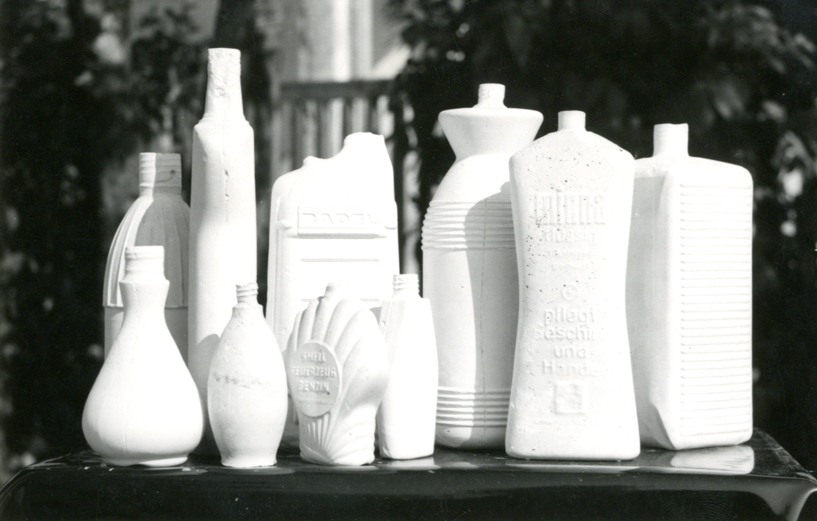 Plaster Casts of Bottles and Other Objects, 1965–68, p. 33
Plaster Casts of Bottles and Other Objects, 1965–68, p. 33
I discovered plaster as a material capable of both reproducing an object down to the minutest detail and annihilating its utility at the same time. This was consistent with the OHO doctrine which demands that objects, and generally all entities, should be liberated of human appropriation in terms of purpose, function, sense, etc.
Matchbox Labels, 1968, p. 36
Matchboxes presented an opportunity for artworks to break free of the grip of cultural institutions and appear in everyday life without institutional intervention. I would buy boxes of matches, paste OHO labels over the original ones, and resell the matches at the same price at our stall in the arcade of the Kazina building in Ljubljana.
Programmed Environment, 1969, p. 52
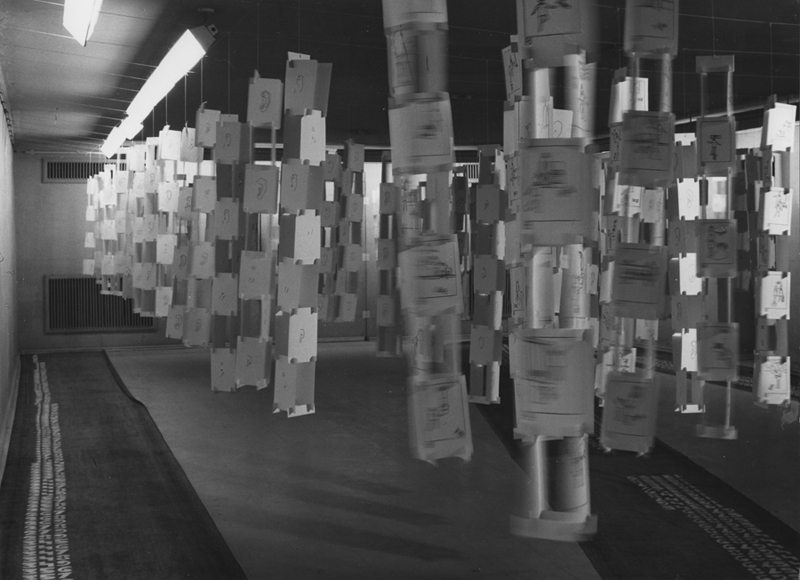 I became interested in programmed art before we even knew of the existence of computers, because programming allows for a work of art to be made according to its own logic, without the touch of human intervention. In this particular case I designed a numerical program that independently determined the points in space where the mobiles should be hung. The numerical program is written on the carpet on the floor.
I became interested in programmed art before we even knew of the existence of computers, because programming allows for a work of art to be made according to its own logic, without the touch of human intervention. In this particular case I designed a numerical program that independently determined the points in space where the mobiles should be hung. The numerical program is written on the carpet on the floor.
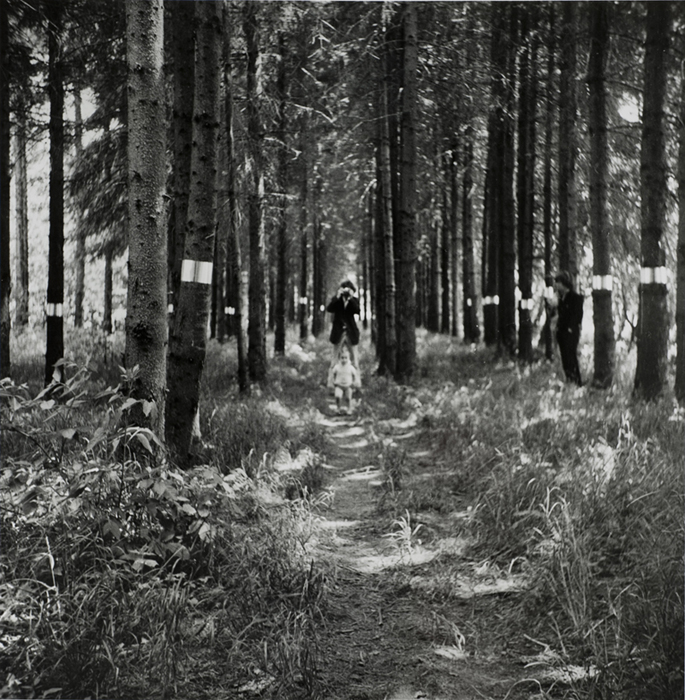 Programmed Wood, Summer 1969, p. 58
Programmed Wood, Summer 1969, p. 58
In this case, I applied the numerical program to a wood near Kranj where fir trees were planted in straight rows, which made programming possible. The firs selected by the program had a strip of polished aluminum attached to them.
Family of Fire, Air and Water, 1969, p. 59
I have always been fascinated by the reactions between the four elements. This is a series of projects that involve two of the given elements each, in different combinations. The number of combinations is further increased with the relationship between the elements being passive and active. Thus, for instance, there are the projects Water – Air, Static that I carried out on the Sava River near Kranj, as well as Water – Air, Dynamic, which was carried out on the island of Srakane in the Adriatic Sea.
Project, Summer 1969, p. 60
In addition to working with the elements of water, air, and fire I was intrigued by the question how I might work with the element of earth without damaging the Earth. Ecological ethics was very important to us. In this case, I drew a circle on the ground, removed the turf inside the circle so that the earth was visible, and then carefully replaced the turf. The process was documented.
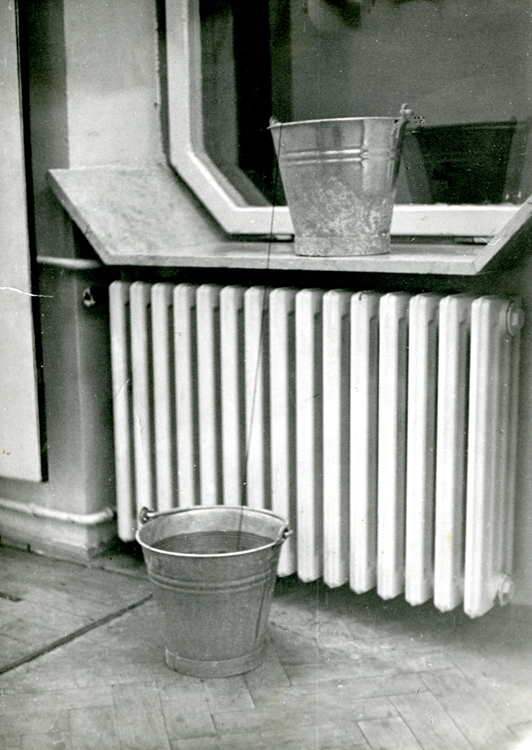 Project – Water Oozing from the Lower into the Upper Bucket on a Woolen Yarn, 1969, p. 66
Project – Water Oozing from the Lower into the Upper Bucket on a Woolen Yarn, 1969, p. 66
This was one of the installations at the above-mentioned show Great-Great-Grandfathers at the Galerija Tribine Mladih in Novi Sad. I wanted to show the crucial difference between the possible and the actual. Theoretically, water should travel from the lower bucket to the upper bucket due to osmosis; in practice, this does not happen. What interested me here was how I could visibly demonstrate something invisible, namely, the difference between a theoretical possibility and the actual state of affairs.
Family of Weight, Measure and Position, 1969, p. 67
This was another series of installations in which I tried to make something invisible visible. Here, this was gravity, a force that works everywhere, although it does not appear per se in the field of the visible. In the first example you are asking about, I “captured” gravity conceptually through the precarious relation between razor blades, strings, and weights. In the other case, the gravitational tension is conveyed through the relationship between rubber and a five-kilogram weight.
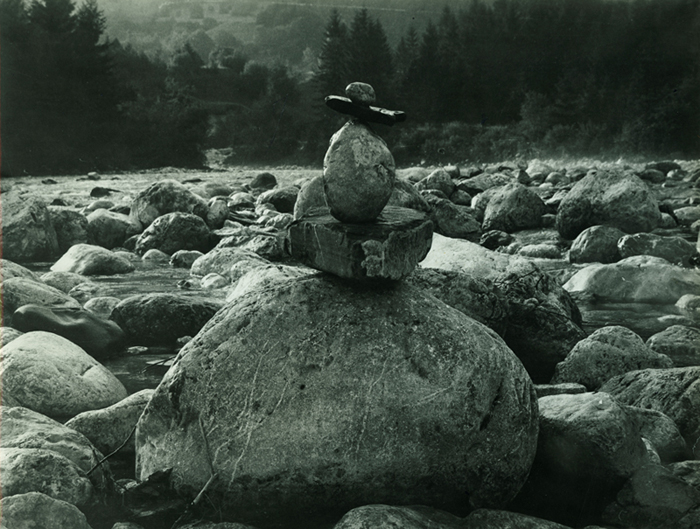 Project – Schooling in ?ezso?a, 1970, p. 73
Project – Schooling in ?ezso?a, 1970, p. 73
Group schooling in ?ezsoša was meditative in nature. For a week, we lived and worked as a group. We also tried out various forms of creative meditation, for instance, arranging small boulders from the So?a River and drawingtheir shadows. The schooling in ?ezso?a, like the Zarica Valley projects, was about searching for a way to continue working both with the body and with spiritual dimensions. We wanted to develop an art that would enable people to come to know themselves and experience the profound dimensions of space at the same time. Understandably, we needed to test everything on and by ourselves first. The schooling was divided into daytime and nighttime exercises. Daytime exercises comprised such things as developing various forms of group walking through the countryside or town, which resulted in experiencing space physically and spiritually. An example of a nighttime exercise would be contemplating the starry sky. We later transformed this experience of schooling into a commune.
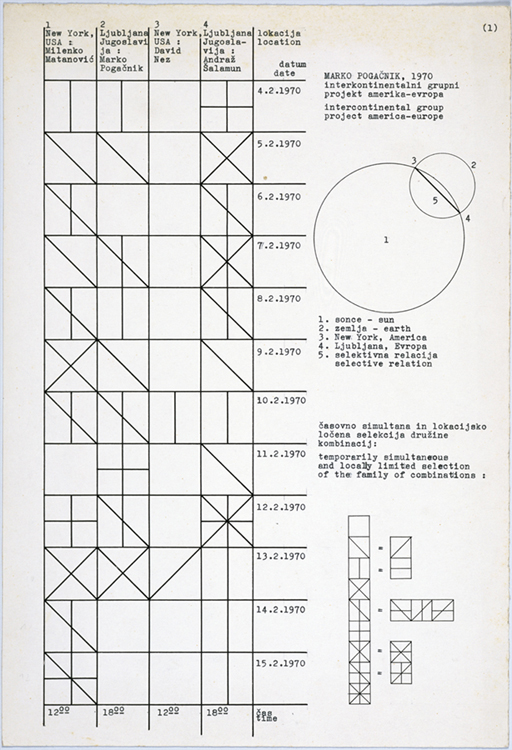 Intercontinental Group Project America – Europe, 1970, p. 75
Intercontinental Group Project America – Europe, 1970, p. 75
When Milenko and David went to stay with David’s family in the United States for a month, I suggested that we test the possibility of communicating telepathically between two members of the group on this side of the ocean, and two on the other side. We arranged the combinations of signs and the times when the signs were to be selected. The results of our telepathic communication are presented in the form of tables in the catalogue.
Project OHO, 1970, p. 86
In the first place, the Project OHO is about the cosmology of OHO as a name based on the alogical structure of squaring the circle (two circles and a square in the middle); secondly, it is also about the archetypal division of roles between the four of us in the OHO Group. The premise is that all primitive cultures knew the principle of their cosmic origin. If OHO is to be constituted as a holistic culture, it must develop its cosmology. I set about doing this as a project. I noticed that the name OHO consisted of two circles (O) and two squares (H). The circle and the square represent the two polar principles, the female (O) and the male (H) ones. The group is in fact a synthesis of both these principles, and the synthesis occurs on the basis of the unsolvable mathematical problem of squaring the circle. I observed the ways in which each of us approached their respective projects, and divided between us the four roles contained in the name of the OHO Group on the basis of my observations.
Medial Systems, April 1970, p. 90
Medial Systems spans eight years of my work, beginning in 1962 when I transformed a bedrock boulder in the Zarica Valley of the Sava River, thus marking the location of the project. (See photo on p. 29 in the catalogue.) Only in 1970 was I able to come up with a corresponding concept. This is based on a template of creation called the Flower of Life, or Vesica Piscis. Medial shapes of animals are a symbolic example of how the template of creation transforms the forms of the world as it is now. I demonstrate this transformation with medial forms between animal and geometric shapes. This is my life’s work, it’s what I continue doing to this day – in another form, of course.
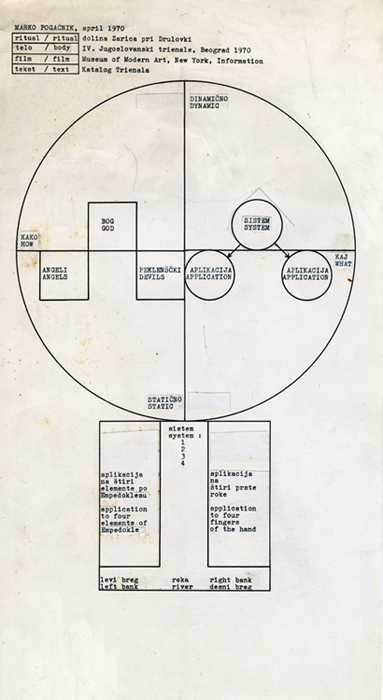 The OHO Group-Man, 1970, p. 93
The OHO Group-Man, 1970, p. 93
This was another ritual carried out in the Zarica Valley, near the village of Breg. It complemented the Project OHO mentioned above. The ritual consisted in each of the members of the OHO Group throwing a stone into a circle we had prepared beforehand. The position of the thrown stone determined the thrower’s position. The final, fourth throw decided that David Nez was the embodiment of the group nature of the OHO Group.
Project (God – Angels – Devils), 1970, p. 96
This was a highly conceptual work visualizing the relation between a system (causal level) and its application (resulting structures of the system.) I took the notion of God as an example of the causal level, that is, a notion that is whole in its nature. When this notion is applied in the physical world, it appears in a polarized fashion. Both the notion of the good (“angels”) and the bad (“devils”) can be associated with the notion of divinity. I arrived at the concept in this way. I repeated the procedure at the next level. There I transformed the described notion into two of its possible applications. For the applications I selected the two banks of the Sava River (this corresponds to the opposing notions of angels and devils). I then went a step further and translated the two oppositions into two actions recorded on film. On one bank I showed, one after another, the four elements according to Empedocles (water, fire, earth, air), and on the other bank, the four fingers of my left hand, one after another.
[su_menu name=”OHO” class=””]



